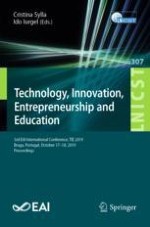2020 | Buch
Technology, Innovation, Entrepreneurship and Education
3rd EAI International Conference, TIE 2019, Braga, Portugal, October 17–18, 2019, Proceedings
herausgegeben von: Cristina Sylla, Ido Iurgel
Verlag: Springer International Publishing
Buchreihe : Lecture Notes of the Institute for Computer Sciences, Social Informatics and Telecommunications Engineering
